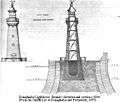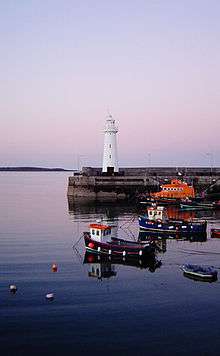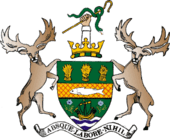Donaghadee
Donaghadee (/dɒnəxəˈdi/[3] or /dɒnəˈdiː/[4] or /dɒnəkʌˈdiː/; from Irish: Domhnach Daoi, meaning "Daoi's church")[5] is a small town in County Down, Northern Ireland. It lies on the northeast coast of the Ards Peninsula, about 18 miles (29 km) east of Belfast and about six miles (10 km) south east of Bangor. It is in the civil parish of Donaghadee and the historic barony of Ards Lower.[5] It had a population of 6,869 people in the 2011 Census.[6]
| Donaghadee | |
|---|---|
 Aerial View of Donaghadee. | |
 Donaghadee Location within County Down | |
| Population | 6,869 (2011 Census) |
| District | |
| County | |
| Country | Northern Ireland |
| Sovereign state | United Kingdom |
| Post town | DONAGHADEE |
| Postcode district | BT21 |
| Dialling code | 028 |
| Police | Northern Ireland |
| Fire | Northern Ireland |
| Ambulance | Northern Ireland |
| UK Parliament | |
History
.jpg)
In the 17th century Ulster ports began to rise in prominence. In 1625 William Pitt was appointed as Customer of the ports of Newcastle, Dundrum, Killough, Portaferry, Donaghadee, Bangor and Holywood. In 1637 the Surveyor General of Customs issued a report compiled from accounts of customs due from each port and their "subsidiary creeks". Of the Ulster ports on the list, Carrickfergus was first, followed by Bangor, Donaghadee and Strangford.[7]
The town also featured in the Irish Rebellion of 1798. On the morning of Pike Sunday, 10 June 1798 a force of United Irishmen, mainly from Bangor, Donaghadee, Greyabbey and Ballywalter attempted to occupy the town of Newtownards. They met with musket fire from the market house and were defeated.
Donaghadee was used in the 1759–1826 period by couples going to Portpatrick in Scotland to marry, as there was a daily packet boat. During this period, Portpatrick was known as the "Gretna Green for Ireland".
The lifeboat station at Donaghadee harbour, founded in 1910, is one of the most important on the Irish coast. RNLB Sir Samuel Kelly (ON 885) is a famous lifeboat once based in Donaghadee and now on show and preserved at the harbour for her gallant efforts over 50 years ago. On 31 January 1953 the lifeboat rescued 32 survivors in the Irish Sea from the stricken Larne–Stranraer car ferry, MV Princess Victoria.
Demography
On Census day (27 March 2011) there were 6,869 people living in Donaghadee (2,997 households), accounting for 0.38% of the NI total.[6] The Census 2011 population represented an increase of 6.1% on the Census 2001 figure of 6,470.[8] Of these:
- 18.43% were aged under 16 years and 22.03% were aged 65 and over;
- 51.89% of the usually resident population were female and 48.11% were male;
- 82.84% belong to or were brought up in a 'Protestant and Other Christian (including Christian related)' religion and 6.39% belong to or were brought up in the Christian Catholic faith;
- 76.58% indicated that they had a British national identity, 31.26% had a Northern Irish national identity and 5.71% had an Irish national identity (respondents could indicate more than one national identity);
- 44 years was the average (median) age of the population;
- 11.98% had some knowledge of Ulster-Scots and 2.48% had some knowledge of Irish (Gaelic).
Places of worship
- Donaghadee Free Presbyterian Church
- Shore Street Presbyterian Church
- First Presbyterian Church, Donaghadee
- Donaghadee Parish Church, Church Place
- St Comgall's Church, Millisle Road, Donaghadee
- Donaghadee Methodist Church, Moat Street, Donaghadee
Places of interest
Harbour and lighthouse
Donaghadee is probably best known for its lighthouse and harbour. For centuries, it has been a haven for ships, and the harbour has been there from at least the 17th century.
Sir Hugh Montgomery built a large stone quay to accommodate vessels ferrying between Scotland and Ireland from 1616 onwards.[7] Viscount Montgomery's harbour (1626; improved 1640), superseding what had hitherto been probably only a small jetty, was built and maintained as a result of the Royal Warrant of 1616 which limited travel between the Ards and the Rhins of Galloway to this port, and that at Portpatrick also owned by Montgomery. It was described by Harris in 1744 as 'a curving quay about 400 feet (120 m) long and 22 feet (6.7 m) wide built of uncemented stones'. It ran from the shore at the north end of the Parade in a broad arc, bent against the open sea, towards the southern end of the present north pier. Much patched and decrepit, the quay was virtually rebuilt, though along the original line, between 1775 and 1785 by the landlord, Daniel Delacherois, probably with the help of John Smeaton, a civil engineer who had apparently made earlier more elaborate plans for extending the harbour, and had just rebuilt Portpatrick harbour.
The old quay remained until after the completion of the new harbour, and then, despite its continued favour by local fishermen, was removed for local wall building about 1833. (It appears in the 1832 drawing but not on the first O.S. map of 1834). The foundation stone of the new harbour was laid by the Marquess of Downshire on 1 August 1821. The initial plans and surveys for this ambitious undertaking were made by John Rennie Senior, the celebrated engineer whose works included Waterloo, Southwark and London Bridges over the Thames. He died within two months of work beginning, and was succeeded by his son, John, later Sir John Rennie, who had as his resident engineer a fellow Scot, the seasoned marine builder, David Logan, who had assisted Robert Stevenson at the Bell Rock Lighthouse (1807–1810).
The new harbour had to have greater depth to accommodate steam packets. Rock blasted from the sea bed, within the harbour area and further south in what became known as the Quarry Hole at Meetinghouse Point was used to form the outer slopes of the two piers; but the inner faces were built of limestone from the Moelfre quarries of Anglesea. This "Anglesea marble" lends itself to the finest ashlar dressing and the new piers remain a triumph of stone carving. The flights of steps display special skill in the deep diagonal binding of each solid step, providing a typically robust engineer's response to the wear of seaboots and waves alike. The harbour consists of two independent piers running north westwards out to sea; parallel nearer the shore, they converge at the outer ends to form a harbour mouth 150 feet (46 m) wide. At low tide the water in the harbour is fifteen feet deep.
 Original plans by John Rennie
Original plans by John Rennie Photo of Donaghadee Town and South Pier
Photo of Donaghadee Town and South Pier Photo of Donaghadee Town and South Pier
Photo of Donaghadee Town and South Pier Donaghadee Harbour and lighthouse
Donaghadee Harbour and lighthouse Donaghadee Harbour and town
Donaghadee Harbour and town Mouth of Donaghadee Harbour
Mouth of Donaghadee Harbour
The Moat
The Moat in Donaghadee was built to house the explosives for the blasting involved in the construction of the harbour. It is one of the most prominent features of the town. The Motte, or the Moat as it is known, dates back to 1818. Today it is part of a park, giving views across the town and seawards towards the Copeland Islands. The original mound was of Norman origin, when a motte and bailey stood on the site. It was initially used as a defensive structure, and provided an excellent look-out post.
 Donaghadee Motte
Donaghadee Motte Donaghadee Moat
Donaghadee Moat

Other activities
Scenic walks include the marine walk at The Commons, which comprises a 16-acre (65,000 m2) semi-cultivated open space with bowls, tennis, putting and an adventure playground. There are several restaurants and pubs in the town, including Grace Neill's, opened in 1611 as the "King's Arms", and which claims to be the oldest bar in all of Ireland, a record, however, held by Sean's Bar in Athlone.
Copeland Bird Observatory
The Copeland Bird Observatory is situated on one of the three islands not far, and to be seen, from Donaghadee. It collects data on the migrating birds and by ringing them records the movements of the migratory species.[9]
Wildlife
Flora
Among the algae recorded from Donaghadee are Gastroclonium ovatum, Callophyllis laciniata, Fucus ceranoides, Desmarestia ligulata, Hordaria flagelliformis, Codium fragile ssp. atlanticum and Cladophora pygmaea.[10]
Donaghadee Male Voice Choir
Donaghadee Choir was founded in 1932. It began as a small local chorus performing in churches and other local functions. The choir's reputation for excellence extends far beyond the shores of Northern Ireland and Great Britain. Today it is known internationally – having performed on stage, radio and television as far afield as the US, Canada, Malta and Bulgaria, where it was the first choir from Ireland to perform behind the former Iron Curtain.
The Choir has been extremely successful in competition, chalking up over 40 firsts in the male voice and open sections of many prestigious festivals in Britain and Ireland. These include Whitby, Morecambe, Wharfedale, Cheltenham, Bangor, Coleraine and more recently, at the AIMS New Ross Festival, where it achieved one of the highest marks ever given. It has also competed at the world-famous International Eisteddfod in Wales. The choir celebrated its 75th anniversary during the 2007/08 season.
Donaghadee in the media
- Donaghadee served as the basis for fictional town Donaghadoo in the children's television series Lifeboat Luke, which was animated by the Donaghadee animation studio STRAANDLOOPER.[11]
- Donaghadee was used as a set for some of the film Mickybo and Me. Dozens of local residents were recruited as extras.
- Donaghadee also featured in the films Robot Overlords starring Gillian Anderson, Divorcing Jack, Killing Bono and Mo the Mo Mowlam story, starring Julie Walters.
Notable people
- Bear Grylls, adventurer, writer and television presenter was raised in Donaghadee until he was 4 – his grandmother was Patricia, Lady Fisher.[12]
- Lord Ashdown
- Maynard Sinclair, Deputy Prime Minister of Northern Ireland, lived in Donaghadee.
- Sir Walter Smiles and his daughter Patricia, Lady Fisher (both Ulster Unionist Party Westminster MPs) lived in the town.
- Sarah Grand, author and feminist
- Sylvia, Lady Hermon, former MP for North Down
- John Magowan, PDC Darts professional
- Two Door Cinema Club, rock band [13]
Sports
Donaghadee has facilities for a number of sports including cricket, tennis, bowling, darts, golf, women's hockey, football, sailing and rugby with teams that compete in various local leagues.
Donaghadee Rugby Football Club
The formation of a rugby club in Donaghadee in 1885 came during a period of rapid growth for the game throughout Ireland. A review of sport in the Newsletter in December that year concluded; "Football has rapidly worked its way into the very front rank of our outdoor sports. The two codes of football – rugby and association – can claim a very large and increasing constituency in this country and the first half of the season has afforded ample evidence that, apart from the increasing numbers, our players are making remarkable strides in the science of the game."
It was against that background that the new Donaghadee Club, formed by the Rev. Coote made its first match against Bangor on 7 November 1885. The game ended in a draw.
From DRFC website:
"The game was played in Donaghadee, possibly on the field behind the Church of Ireland Rectory – in other words on the very same place the Donaghadee club uses to this day."
The club's grounds currently go under the name of Donaldson Park
Donaghadee Cricket Club
Donaghadee Cricket Club is a member of the NCU Senior League.
Donaghadee Ladies' Hockey Club
Donaghadee Ladies' Hockey Club has been around since pre-war times. They currently have two teams which play in Ulster Hockey leagues: The 1XI play in Senior League 3, while the 2XI are in Junior 8. The club training night is Wednesday from 7.30pm to 9pm at Bangor Grammar School. Club colours are red, green, red. For more info, find them at donaghadeelhc.co.uk or on Facebook, Instagram and Twitter.
Donaghadee Golf Club
Donaghadee Golf Club was founded in 1899 by Stephen Mccausland and is part links and part open parkland. The course has recently undergone a major course refurbishment with the addition of many new bunkers. The 18th hole is a finishing hole with out of bounds on both left and right, while the sea breeze can provide an extra challenge to visitors. This area of the County Down coastline and Donaghadee in particular provides views over the nearby Copeland Islands. The 16th tee is an excellent vantage point and the hills of south west Scotland can be visible in the distance on a clear day. The club also provides catering facilities in the clubhouse. The golf club has a proud history, winning its second all Ireland trophy in 2007. This was the Irish CLub Youths. They then won their 3rd All Ireland Title in 2012 when Gareth Stranagan's side beat Athenry 4/1 in the Junior Cup final in Kinsale.
"Donaghadee Golf Club is worth a visit for the golf enthusiast. It is an 18-hole part links and parkland course. Clubhouse has the essential bar and restaurant to keep the visitors and members refreshed. A snooker room is available to keep visitors busy. A pro shop tends to the shopping needs of the visitors. Club and trolley hire facilities are also available."
Donaghadee Sailing Club
Donaghadee Sailing Club has recently undergone a redevelopment and in May 2009 the new clubhouse opened.[14]
Darts
Various pubs and clubs enter darts teams in the local league, from both Donaghadee and Millisle, including Meadowbank Social Club and the Tivoli Bar. Former PDC Darts professional John Magowan lives in the town and has been a loyal servant to Northern Ireland darts for the past three decades.
Donaghadee Football Club
Donaghadee F.C. are junior football who play their home matches at Crommelin Park in the town. For the 2014-15 season they are members of Division 2C of the Northern Amateur Football League.[15] An earlier club of the same name held membership of the same league from 1948 to 1953.
Donaghadee FC and Donaghadee 11s were both promoted from their respective leagues in 2016/17. [16]
See also
- Donaghadee (civil parish)
- Donaghadee lighthouse
- Lighthouses in Ireland
- List of localities in Northern Ireland by population
- List of towns and villages in Northern Ireland
- List of civil parishes of County Down
- List of RNLI stations
- Market Houses in Northern Ireland
- Belfast and County Down Railway
References
- Wricht, Jhone. "Tha spairk o it". Ullans: The Magazine for Ulster-Scots. Ulster-Scots Academy. Retrieved 8 May 2017.
- McDonald, Fiona. "Fae Cowie's Craig". Ulster-Scots Language Society. Retrieved 8 May 2017.
- Pointon, GE (1990). BBC Pronouncing Dictionary of British Names (2nd ed.). Oxford: Oxford University Press. p. 76. ISBN 0-19-282745-6.
- https://www.buzzfeed.com/robynwilder/ball-a-hoolish 13 of the most difficult plac names and how to pronounce them; accessed 28 June 2018.
- "Donaghadee". Place Names NI. Retrieved 21 February 2013.
- "Census 2011 Population Statistics for Donaghadee Settlement". Northern Ireland Statistics and Research Agency (NISRA). Retrieved 6 August 2019.
- O'Sullivan, Aidan; Breen, Colin (2007). Maritime Ireland. An Archaeology of Coastal Communities. Stroud: Tempus. pp. 208–212. ISBN 978-0-7524-2509-2.
- "Census 2001 Usually Resident Population: KS01 (Settlements) - Table view". Northern Ireland Statistics and Research Agency (NISRA). p. 3. Retrieved 6 August 2019.
- http://www.thecbo.org.uk/
- Morton, O. 1994. Marine Algae of Northern Ireland. Ulster Museum ISBN 0-900761-28-8
- "STRAANDLOOPER". Retrieved 2 May 2013.
- Martin, Charlotte (17 April 2004). "MY LIFE IN TRAVEL: Bear Grylls". London, UK: The Independent. Retrieved 3 June 2009.
- https://twitter.com/tdcinemaclub/229022369564487680
- Donaghadee Sailing Club Website; accessed 26 May 2014.
- Donaghadee F.C. at the NAFL site
- NAFL history (Roll of Clubs from 1923)
| Wikimedia Commons has media related to Donaghadee. |
Further reading
Allen, Harry. 2006.Donaghadee An Illustrated History. ISBN 1870132319
Hill, I. 1986. Northern Ireland. The Blackstaff Press. ISBN 0-85640-365-2

